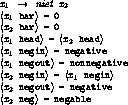


Next: Transfer examples Up: Illustration Previous: Illustration
Negation
The most interesting type of negation - from a translational point of
view - is vp-negation, so we will leave other types outside this
discussion. Neutral vp-negation for English seems quite
straightforward as the negation element `not' appears immediately
after the first auxiliary verb. For Dutch, matters are more complex.
According to [15], the negated element in principle immediately
precedes the verb if the VP does not contain any other scope
bearing element at the left of the verb. It appears directly left of the
leftmost scope bearing element otherwise. It even attaches to it
morphologically in the case of the indefinite article. Relevant data are
the following:
dat Jan Marie de foto niet geeft
(that John Mary the picture not gives)
that John doesn't give Mary the picture
dat Jan Marie geen foto geeft
(that John Mary no picture gives)
that John doesn't give Mary a picture
dat Jan Marie niet alle foto's geeft
(that John Mary not all pictures gives)
that John doesn't give Mary all pictures
Our implementation of this phenomenon makes use of `threading' [26].
The features negin and negout are used to pass the information through
the left corners of the constituents.
A vp containing a negative marker will thus have the feature
negin = negative, which value will be preserved in translation. The
negout-value of vp's is constrained to be nonnegative.
The grammar rule that introduces the negative element is the following (simplified) :

All lexical items carry the information negin = negout.
Those that may
occur as the left-corner of constituents which do not bear scope - e.g.
definite determiners in definite NPs - are marked neg = nonnegable.
This prevents the negative element to occur in front of non-scope bearing elements.
The indefinite, inherently negated determiner
`geen' (`no') is specified as negin = negative, negout =
nonnegative. It prevents this determiner from being doubly negated,
that is, the rule above does not apply. And besides, it returns the
in-value negative which, in the end, will be preserved in translation.
Some sample lexical entries and their behaviour in negative vp's
illustrate this further:
de : negin = negout, neg = nonnegable (the)
alle : negin = negout, neg = negable (all)
geen : negin = negative, negout = nonnegative (no)
geven : negin = negout, neg = negable (give)
...dat Jan Marie de foto niet geeft
.*.dat Jan Marie niet de foto geeft
.*.dat Jan Marie alle foto's niet geeft
...dat Jan Marie niet alle foto's geeft
...dat Jan Marie geen foto's geeft
The threading technique proved to be very useful for English as
well. In some special cases, the negation marker can also be realized
in more than one way.
Compare the following pairs:
The minister promised nothing
The minister didn't promise anything
The minister never makes promises
The minister doesn't ever make promises
The only difference between `anywhere' and `nowhere'
(and similarly `anything' and `nothing') is that the first has an
in-value equal to the out-value whereas the latter has the in-value
set to negative and the out-value to nonnegative. Translation of
the Dutch structure a) will yield either b) or c) in English :
a) De minister belooft niets
b) The minister doesn't promise anything
c) The minister promises nothing



Next: Transfer examples Up: Illustration Previous: Illustration
Gertjan van Noord
Thu Nov 24 18:57:05 MET 1994